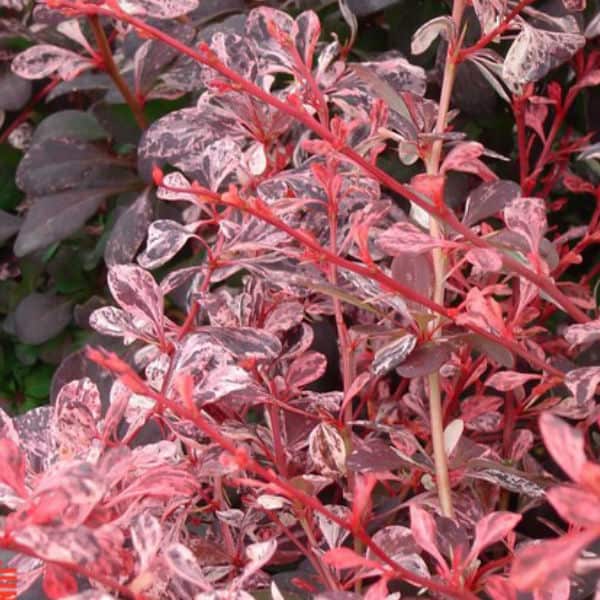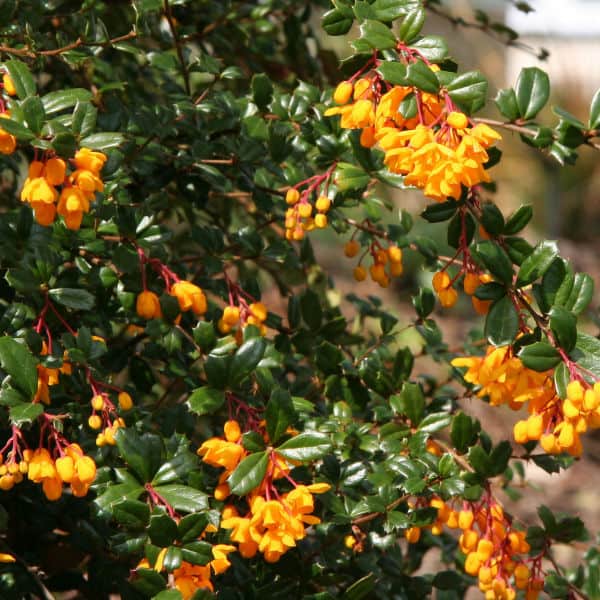Last updated on January 25th, 2022
Our site is reader supported, this means we may earn a small commission from Amazon and other affiliates when you buy through links on our site.
Berberis Pruning
Berberis is also commonly known as the Barberry plant and with over 500 different species it is found in nearly every country around the world. It can be seen to be used in many different ways, from forming both formal and informal hedges to border shrubs. This prickly shrub is available as both an evergreen and a deciduous shrub. The two types should be pruned in different ways. Their foliage colours range from the dark green spiky, thick-set leaves of Berberis ‘Darwinii’ often seen as evergreen hedging and groundcover shrubs to the soft ovate leaves of Berberis thunbergii varieties. Some of these varieties have attractive red leaves that are mottled with cream before turning to a fiery red colour in the autumn.
Before pruning Berberis make sure you have a good pair of gardening gloves and long sleeve jumper to protect you from their very sharp and unforgiving thorns. It may also pay to wear safety glasses if you are planning on reaching deep into the centre of the plant or using a hedging cutter.
Pruning deciduous cultivars
Deciduous Berberis, which includes most of the Berberis ‘thunbergii’ and x ottawensis types, are best pruned when they are dormant and have dropped their leaves for the winter. B ‘Atropurpurium’ is an example of one of the popular varieties often planted as large shrubs and in informal borders. These flower on the previous year’s growth and this means that any hard pruning that is done in the spring (before flowering) would remove all the flower shoots for the upcoming year. The best way to get around this is to prune them no later than the end of February. Instead of cutting back hard, remove 1 in 4 stems to ground level, removing the old stems first. This will encourage new growth in spring and allow light to reach into the centre of the shrub. In spring after flowering, you can then cut back one third of the finished flowering growth.

If you are prepared to lose some of the flowering growth in spring and want to encourage more foliage to be produced to form a denser shrub, then you can remove even more of the old wood and prune 1 in 3 stems back to ground level. This will give a fantastic display of orange/red colours in the autumn.
Hard pruning of deciduous Berberis
If you need to do some hard pruning then this needs to be done in early summer after flowering. They can be pruned back hard without any problems and pruning early will ensure they have time to produce lots of new growth in summer that will flower the following year in spring. If you prune back hard any later it will not have time to produce new foliage and therefore it will not flower the following year.
Pruning evergreen Berberis
Evergreen berberis such as Darwinii, Julianae, Linearifolia and the x media flower in spring on the previous year’s growth and are best left unpruned, except for the removal of any damaged, diseased or dead branches. This can be done after flowering with a good pair of secateurs. Simply trim back after flowering to shape the bush and deadhead the spent flowers.

Berberis ‘Darwinii’ – Image:wikimedia.org
Hard pruning of evergreen Berberis
If you want to hard prune an evergreen Berberis that has got too large for its position then it can suffer if pruned too hard and have been known to never recover.
The best way to try and avoid this is to prune back by a third in spring after flowering (usually around March) and then in mid-summer prune again by about half when new growth has started to fill in where it was pruned to the first time. Prune for a final time around September to get it to the final desired height. Cutting it in 3 stages is usually less of a shock to the plant and will ensure your Berberis grows back healthily.
Trimming Berberis hedges
Due to the nature of them, most Berberis hedges will not flower as you trim off most of the previous year’s growth which the plant would usually flower on. Formal Berberis hedges are best trimmed after flowering in the spring and then again as they become untidy. They usually form a better hedge when trimmed 2-3 times a year and although they will lack flowers they will form a dense compact shape. Deciduous varieties will look beautiful in Autumn when the leaves turn red.
If you want to plant a hedge and have lots of flowers, then try to plant an informal hedge, let the hedge grow wilder and cut it to shape after flowering in spring. The new growth will then flower again the following spring.
Feeding evergreen and deciduous berberis after pruning
Berberis are hardy plants and tolerant of most soil types but feeding them after pruning will encourage new growth. Feed with a good multi-purpose feed or a rose fertiliser, such as Doff rose feed or a similar feed, which is high in potassium. Mulching will also help suppress weeds and retain moisture.



4 Comments
I want to take off 2 feet in height of my Berberis.Can i do this early summer without harming my hedge.
Hi Thomas, yes it should be fine to prune berberis early summer, there are very robust and won’t be harmed.
I have planted a berberus this year which now has one stem growing very tall from the middle should I trim this down or leave it
I would trim it off, it won’t do it any harm and will encourage the rest of the bush to bush our more. Hope this helps.